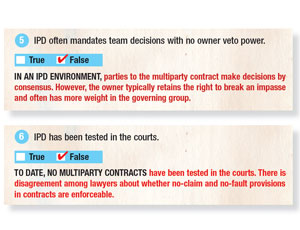More than five years into a collaborative building-production movement called integrated project delivery, warnings abound: Don’t try this with strangers. New risks replace old ones. Beware of waivers of claims. Get ready to open your books. Expect lengthy contract negotiations. Prepare to share any profits. Understand that multiparty contracts have not been tested in court.



The advice is not just from lawyers and skeptics. Even IPD zealots admit IPD may change the designers’ standard of care. They acknowledge there are no insurance products covering multiparty contracts. They caution that successful IPD demands building teams adopt a non-adversarial mentality.
The latest shift toward team-centric project delivery, in which the owner, architect and contractor sign a single contract, is still not consistently defined, understood or practiced, agree the experts. “This will take some time to shake out,” says IPD veteran Scott Simpson, senior director of architect KlingStubbins, Cambridge, Mass.
However, the unsettled situation doesn’t rattle IPD boosters. “We have drunk the Kool-Aid,” says Simpson.
As proof of concept, IPD vets show off their successful IPD work. The projects, they chorus, were produced with less agita and more collaboration and camaraderie. They were finished with high quality. They were on time and on budget. They were completed with no claims.
IPD’s collective swim-or-sink environment, created by a contract that mandates cooperation, reduces the likelihood of designers and contractors padding costs, say IPD supporters. It also reduces the likelihood of construction delays, because most problems are solved by the team before the problems reach the field.
“The only way you can truly understand and appreciate the benefits of IPD is to actually go through two or three projects from beginning to end,” says Tom Leonidas Jr., a vice president of Seattle-based electrical engineer Sparling.
Watch each others’ backs? Open books? Pay for each others’ mistakes? Reveal profits? Waive claims? Not interested, say many building experts.
IPD is “almost all hype,” says Art Gensler, chairman of the 2,300-plus-person architect that bears his name. The San Francisco-based architect maintains that multiparty contracts are not in the best interest of architects, good design or the client. It’s not a plus to have “the architect and contractor in bed together,” he says.
Some owners are wary of IPD because most multiparty agreements do not include a guaranteed price. “There are concerns for owners in terms of limiting competitive pricing for construction services,” especially in the current buyer’s market, says Maureen McDonough, director of program administration for Harvard University, Cambridge, Mass.
The no-claims record to date does not impress skeptics. One prominent engineer says as soon as there is a big problem on a project, "Kumbaya will become 'kumbayuck,' the courts will take over and IPD will go the way of total quality control and partnering."
As defined by the American Institute of Architects (AIA) and the AIA California Council (AIACC), IPD is distinguished...



Post a comment to this article
Report Abusive Comment